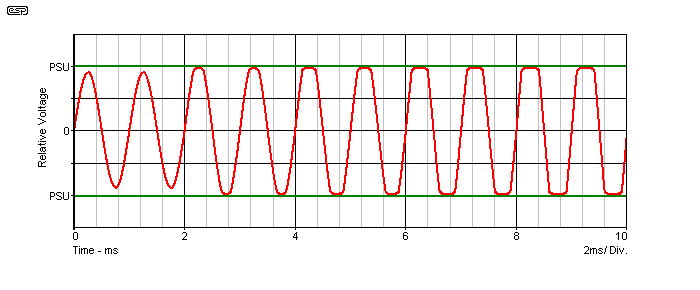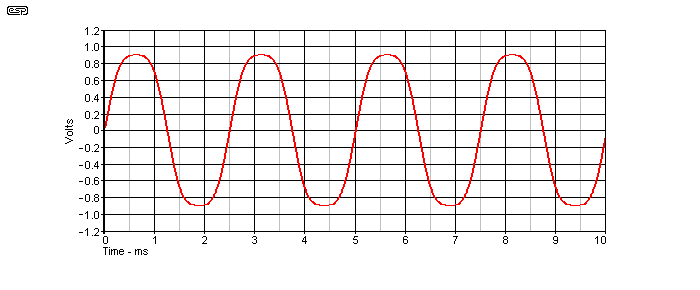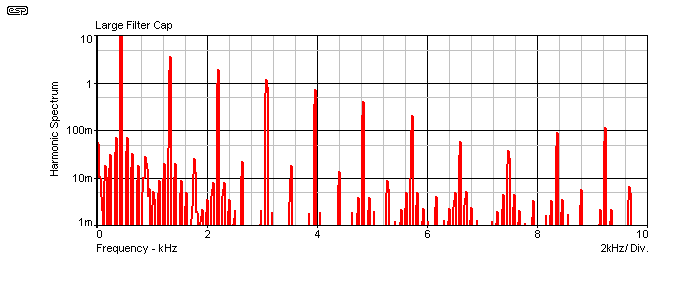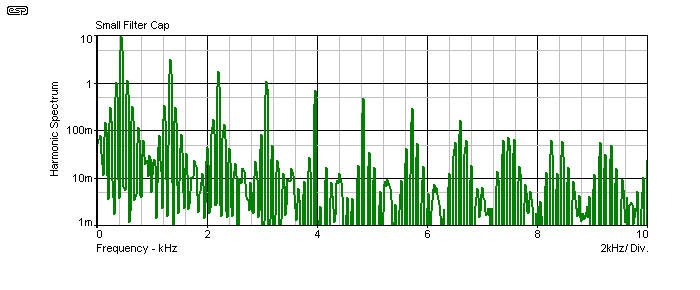

|
| Elliott Sound Products | Valves (Vacuum Tubes) - Clipping |
 Main Index
Main Index
 Valves Index
Valves Index
When any amplifier clips, some power supply ripple always finds its way into the audio. Below the clipping level, the amplifier circuitry is usually capable of cancelling out the effect, but once the amp is no longer operating in linear mode this doesn't happen any more. Any amplifier that is overdriven is not linear - linearity implies that the output voltage changes in a linear fashion based on the input voltage.
It has been suggested (in a service note from Marshall) that the already small filter caps used in some amps must be reduced! Increasing capacitance supposedly 'ruins' the sound, so half of the dual 50uF capacitor is supposed to be disconnected. The dreadful effect of supply ripple is ruined, but very few guitarists will agree that the addition of 100/120Hz amplitude modulation is a worthwhile addition to the sound. Most dislike the mess that's created as a result, so it's safe to assume that Marshall (yet again) really doesn't understand the realities of what musicians really want - as opposed to what someone thinks they want. Needless to say, sensible technicians ignore this 'advice' and keep the full capacitance. Some add more, and the guitarist is invariably much happier with the sound.
When any power amp (valve or transistor) is driven into distortion (aka overdrive), the signal clips. All this means is that the signal amplitude attempts to exceed the power supply voltage, but when the limit is reached the signal just stops because the supply voltage imposes an absolute limit on the maximum signal swing. This is shown below, where the signal is increased from just below clipping to about 50% overdrive - the point where the power supply is only 50% of the desired amplitude. Each 2ms increment on the graph below has the voltage increased, 5 steps in all.

Figure 1 - Waveforms as Clipping Point is Approached and Exceeded
The above assumes that the power supply is perfect - no ripple and no collapse under high loading. It is intended to show how the power supply imposes an absolute limit on the signal in a well behaved amplifier. As you can see, the waveform is symmetrical, with top and bottom peaks of the waveform clipped at the same voltage.
Contrary to what is commonly believed, amplifiers that clip symmetrically are preferred by the vast majority of guitarists, and the harmonics produced are odd - third, fifth, seventh, etc. Asymmetrical clipping distortion produces a sound that generally sounds thin and 'reedy' - in extreme cases it can sound like the amplifier has developed a severe case of terminal flatulence. While it is undoubtedly suited to some material, most guitarists will control the sound by their playing style. One example is picking harmonics - a technique that was probably exemplified on the ZZ-Top track "La Grange". Attempts to get the same sound using asymmetrical distortion are doomed. There is much nonsense on the Net about valve guitar amps and second harmonic distortion, but almost no-one points out that this does not apply to power amplifier clipping.
It must be understood that the issues described here apply when the power amplifier is overdriven. Distortion derived from use of a master volume control or external pedals do not create power supply modulation of the signal, because the power amp is still operating in linear mode, provided the overall volume is low enough to avoid power amp clipping of course. Some players will use a fuzz box and amp overdrive together.
Distortion always creates additional harmonics. Even if you were to play a perfect 'A' (440Hz) with a pure sinewave, once the amp distorts you will get a sequence of harmonics. The seventh is discordant, so guitar speakers are usually designed to roll off their response above about 6kHz, however this is not an exact science, and will still fail to remove the seventh harmonic of notes below 1kHz ... which is almost all of them on a typical fret board and with normal tuning.
The harmonics give the sound more 'bite', increasing the high frequency components. Most accomplished players will become very skilled at knowing which notes can be played together with high distortion levels, but without creating an unholy mess of noise. In other cases, the unholy noise might be just what's required - sometimes, deliberate discords can add a richness that cannot otherwise be obtained.
Distortion also has another effect - the sound is compressed, so sustain is increased. A note or chord will normally die away naturally, but if there's enough gain and (usually clipping induced) compression, the note(s) can be made to sustain indefinitely. This is a very common technique. Jimi Hendrix used it extensively, and vast number of players rely on the sustain to get effects that are quite unique to the electric guitar. In some cases it's augmented by an external sustain pedal, and the ESP projects section has a few projects that are designed for this purpose.
For guitar amps, most of the input stages are biased to provide maximum symmetrical swing, which means that the distortion will be a mixture of even and odd harmonics. At (and beyond) clipping, the distortion is predominantly odd order. The allegedly smooth sound of even order distortion only (particularly the second harmonic, which is claimed to be especially nice), produces a waveform that still tends to look like a sinewave, but just isn't quite right. Intermodulation distortion results from all harmonic distortion - even and odd. For a single instrument (such as guitar) this isn't necessarily a problem, and the playing style is generally changed to accommodate the extra frequencies that result from intermodulation.
In the case of a typical valve circuit approaching clipping, the first odd harmonic is the 3rd, and is 20dB lower than the fundamental. 1V at 400Hz + 100mV at 1.2kHz ... the waveform is shown in Figure 1.

Figure 2 - Symmetrical Waveform at the Onset of Clipping
Audibility is another matter. With a sinewave, it's usually easy enough to detect as little as 0.5% distortion. With guitar, that level is almost impossible to detect by ear. Even much higher levels can be difficult to hear, and this depends a great deal on the speakers and the style of music. Note that these comments are intended as a guide only, and do not include the effects of intermodulation. IMD results from any non-linearity, and is measured with two frequencies.
A common test is to apply signals of (say) 1kHz and 1.1kHz. IMD is measured by looking at the amount of 100Hz (and 2.1kHz) signal produced, since IMD may produces sum and difference frequencies (with asymmetrical distortion), as well as the normal progression of harmonics (and potentially their sum and difference frequencies). This becomes a very important consideration if there is hum on the power supply, as will be shown. However! It must be understood that sum and difference frequencies are only generated with even-order (asymmetrical) distortion. If clipping and the applied waveform are perfectly symmetrical, these frequencies are not created.
Inadequate filtering of the power supply will result in amplitude modulation of the signal. This is exactly the same modulation used for AM radio, except for one important difference. With AM radio the carrier (the frequency you tune to get a particular station) is modulated by the audio (the modulation signal). The carrier is a fixed frequency, but the audio - naturally enough - is not.
When an amplifier that has poor power supply filtering is overdriven, the carrier frequency is the note you are playing, and the modulation signal is the 100/120Hz ripple on the power supply. Figure 3 shows two heavily overdriven signals. The faint pink signal is what you expect (it's deliberately made light so it doesn't distract from the other trace). The green trace shows the effect of significant power supply modulation - you can see the traditional power supply 'sawtooth' waveform on the positive and negative peaks of the signal. This waveform is deliberately exaggerated so the effect is clearly visible.

Figure 3 - Power Supply Ripple Superimposed on Audio Signal
The audio signal is a 440Hz heavily clipped sinewave. While this graph was actually done using a transistor amp, a valve amp is almost identical. Although there are subtle differences, they don't appear to affect the harmonic and sideband structure to any significant extent.

Figure 4 - Harmonic Structure of Well Filtered Clipped Waveform
The progression of (predominantly odd) harmonics is clearly visible. There is some 'clutter' at very low levels, and this is caused by the very small amount of ripple that remained on the well filtered supply. Other than using a regulated power supply (an extremely uncommon practice to put it mildly), this is unavoidable. At over -40dB referred to the fundamental, these artefacts are close to being inaudible.

Figure 5 - Harmonic Structure of Poorly Filtered Clipped Waveform
Compare the harmonic structure of this graph from the previous version. The progression of harmonics is still there, but each is surrounded by 'sidebands' - (and may include sum and difference frequencies). The fundamental of 440Hz has sidebands at 340Hz and 540Hz, plus additional sidebands each displaced by 100Hz. The power supply used to create these graphs was 50Hz - for a 60Hz mains supply, the sidebands are displaced by 120Hz. The effect is especially bad at higher frequencies - above 4kHz you can see that the sideband energy is particularly strong. Any time you see sidebands on an FFT (Fast Fourier Transform) that means there is amplitude modulation (AM).
Overall, the effect is a bit like having two extra strings on your guitar that can (magically) play notes that are 100/120Hz above and below the note you are playing, but at a low level. They activate automatically, and insert themselves into everything that's played whenever the power amp is in overdrive. If a guitar actually had such a 'feature', I have a feeling that it would have very limited popularity. Needless to say, it would play only 100Hz displaced notes in Europe, Australia the UK and many other countries, but would change key and play 120Hz displaced notes in the US, Canada, etc. Would you like a guitar that did this?
Imagine the confusion of a poor guitarist who is used to hearing 100Hz sidebands (and may have even adapted his playing style to suit), who goes to the US and finds that his amp sounds different. While I do accept that this is unlikely (a search didn't reveal anything) it could happen. The character of the underlying sidebands will change quite significantly, but if the power supply is well filtered the problem is minimised to the point where it becomes irrelevant.
I've been told that some guitarists who've tried to get the exact Jimi Hendrix sound (as recorded) have been frustrated, because most of Jimi's recordings were made in the US (60Hz mains frequency, 120Hz modulation). Elsewhere, the amplitude modulation is a different frequency (50Hz mains frequency, 100Hz modulation), so the exact sound cannot be duplicated unless you have access to a 60Hz power source. The early Marshall amps had filtering that's best described as minimal, so amplitude modulation was very noticeable. Of course, this claim may well be a load of old cobblers. 
Any power supply modulation as described is no different from the traditional tremolo effect, except that it's at a much higher frequency. Most guitarists will have found that some amps provide a tremolo speed control that enables them to get a very strange (and generally unpleasant) sound at maximum. This creates sidebands just like the power supply modulation. At typical tremolo speeds, the sidebands are at such a low level that they are inaudible, but if the speed is increased above ~15Hz the effect is just 'dirty' and generally unusable. I don't think I have ever heard any guitarist using very high tremolo speed.
If tremolo at 20Hz sounds pretty gross, it doesn't take much imagination to figure out that tremolo at 100Hz or 120Hz will sound a lot worse. On a sinewave (I used 220Hz for the test), amplitude modulation at 100Hz is clearly audible even when the sidebands are more than 30dB below the fundamental - I didn't test for a lower limit of audibility, simply because a sinewave is far too clean and makes the audibility of any form of distortion too easy. With music, the point where you hear the AM sidebands will vary, with so many dependencies that it cannot be predicted.
Many experienced technicians have already found that at least 99% of players prefer the sound of the amp if capacitance is increased to minimise the modulation. With some (Marshall) amps, the effect is even audible well below the power amp's clipping level. This is especially true if the service note instructions have been followed, because there is significant ripple on the screen grids even at half power or less. The only cure for this is to increase the amount of filtering on the power supply - this means more capacitance.
It is worth noting that if an amplifier is being operated with power amp clipping into a typical speaker cab, it will be extremely loud. So much so that the effects described may not be audible, because your ears simply cannot tolerate the sound level, and will be severely desensitised. If a speaker attenuator is used to reduce the level to that of normal conversational speech, the effect becomes very audible indeed.
Power supplies in all guitar amps (both valve and transistor) need good filtering. The filter capacitors need to be as large as possible, but there is obviously a point where any further increase provides no audible benefit. While a regulated supply prevents any modulation, the sound will not be as most players expect. There is a dynamic effect that allows staccato notes to be loud, yet compresses chords and continuous notes, and many guitarists prefer the sound of valve rectifier diodes for just this reason. The supply voltage collapses under long-term load, reducing power output. Long-term in this context can mean as little as half a second, and recovery to normal full voltage is usually considerably less.
The same effect can easily be produced by simply adding resistance into the supply circuit that allows the supply to collapse under sustained load, and this is preferable to using valve diodes (horrible things that they are). Regardless of deliberate power supply collapse, the filtering needs to be sufficient to ensure that supply ripple modulation is minimal. This is easily achieved in both valve and transistor amps, although few transistor amps have a serious modulation problem.
As a very basic guide, you need about 27µF for each DC watt drawn from a ~450V DC power supply. A 100W amp will require (as very rough estimate) about 150W DC for 100W into the speaker, so the storage capacitance needed is about 300µF. Most guitar amps have less than half that. A nominal 460V supply with a typical 100µF of filtering will produce 23V peak-to-peak ripple at an average DC voltage of 420V. Increasing the capacitance to 300µF reduces ripple to less than 8V p-p, and raises the average voltage slightly to 423V.
For those who think that small caps are better, a 10µF filter cap supplying 150W will have over 180V (peak to peak) of ripple and the average supply voltage falls to only 380V. This is obviously a very bad idea. The peak to peak ripple voltage is almost half the supply voltage! Yes, this is an extreme example, but it serves to illustrate the point.
 Main Index
Main Index
 Valves Index
Valves Index